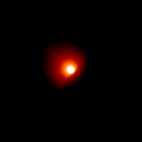|
COMETS EARTH JUPITER KUIPER BELT MARS MERCURY METEORITES NEPTUNE OORT CLOUD PLUTO SATURN SOLAR SYSTEM SPACE SUN URANUS VENUS ORDER PRINTS
PHOTO CATEGORIES SCIENCEVIEWS AMERICAN INDIAN AMPHIBIANS BIRDS BUGS FINE ART FOSSILS THE ISLANDS HISTORICAL PHOTOS MAMMALS OTHER PARKS PLANTS RELIGIOUS REPTILES SCIENCEVIEWS PRINTS
|
Related Document
Download Options
This animation comprises three photographs taken with NASA's Hubble Space Telescope chronicle a violent outburst in the life of comet LINEAR, also known as C/1999 S4. The orbiting observatory's Space Telescope Imaging Spectrograph tracked the streaking comet for two days, July 5 to 7, capturing a dramatic leap in its brightness [first image]; followed by seeing a wave of newly created dust from the outburst flowing into the coma, a shell of dust surrounding the core [middle image]; and culminating in the discovery of a castoff chunk of material from the nucleus sailing along its tail [the bright dot trailing behind the comet in the picture at right]. The white region represents the brightest part of the coma. The nucleus cannot be seen in these images because it is about a mile or so across, which is too small for the Hubble telescope to see. When the Hubble telescope snapped these visible-light images, comet LINEAR was 74 million miles (120 million km) from Earth. At 6:32 p.m. EDT July 5 [left image], Hubble watched as the light within a 50-mile-wide region surrounding the core brightened by about 50 percent in less than four hours. By 5:20 p.m. EDT the next day [middle image], that region was a third less luminous than at its peak the previous day, as the dust expelled from the core during the outburst moved farther out in the coma. By 7:04 p.m. EDT on the final day [right image], the comet's brightness was back to normal -- about one-seventh less luminous than at peak level. The chunk of material seen in the final picture is roughly 290 miles (470 km) from the nucleus and appears to be moving down the tail at about 6 miles per hour. The fragment's slow pace indicates that it could be quite large (possibly house-size), but accurate estimates for the sizes of the chunk and of the core require further analyses of the Hubble images and data from other observatories. Credits: NASA, H. Weaver and P. Feldman (Johns Hopkins University), M. A'Hearn (University of Maryland), C. Arpigny (Liege University), M. Combi (University of Michigan), M. Festou (Observatoire Midi-Pyrenees), and G.-P. Tozzi (Arcetri Observatory) |
